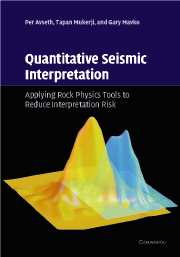Book contents
- Frontmatter
- Contents
- Preface
- 1 Introduction to rock physics
- 2 Rock physics interpretation of texture, lithology and compaction
- 3 Statistical rock physics: Combining rock physics, information theory, and statistics to reduce uncertainty
- 4 Common techniques for quantitative seismic interpretation
- 5 Case studies: Lithology and pore-fluid prediction from seismic data
- 6 Workflows and guidelines
- 7 Hands-on
- References
- Index
- Plate section
1 - Introduction to rock physics
Published online by Cambridge University Press: 27 January 2010
- Frontmatter
- Contents
- Preface
- 1 Introduction to rock physics
- 2 Rock physics interpretation of texture, lithology and compaction
- 3 Statistical rock physics: Combining rock physics, information theory, and statistics to reduce uncertainty
- 4 Common techniques for quantitative seismic interpretation
- 5 Case studies: Lithology and pore-fluid prediction from seismic data
- 6 Workflows and guidelines
- 7 Hands-on
- References
- Index
- Plate section
Summary
Make your theory as simple as possible, but no simpler.
Albert EinsteinIntroduction
The sensitivity of seismic velocities to critical reservoir parameters, such as porosity, lithofacies, pore fluid type, saturation, and pore pressure, has been recognized for many years. However, the practical need to quantify seismic-to-rock-property transforms and their uncertainties has become most critical over the past decade, with the enormous improvement in seismic acquisition and processing and the need to interpret amplitudes for hydrocarbon detection, reservoir characterization, and reservoir monitoring. Discovering and understanding the seismic-to-reservoir relations has been the focus of rock physics research.
One of our favorite examples of the need for rock physics is shown in Plate 1.1. It is a seismic P–P reflectivity map over a submarine fan, or turbidite system. We can begin to interpret the image without using much rock physics, because of the striking and recognizable shape of the feature. A sedimentologist would tell us that the main feeder channel (indicated by the high amplitude) on the left third of the image is likely to be massive, clean, well-sorted sand – good reservoir rock. It is likely to be cutting through shale, shown by the low amplitudes. So we might propose that high amplitudes correspond to good sands, while the low amplitudes are shales.
Downflow in the lobe environment, however, the story changes. Well control tells us that on the right side of the image, the low amplitudes correspond to both shale and clean sand – the sands are transparent.
- Type
- Chapter
- Information
- Quantitative Seismic InterpretationApplying Rock Physics Tools to Reduce Interpretation Risk, pp. 1 - 47Publisher: Cambridge University PressPrint publication year: 2005
- 1
- Cited by



